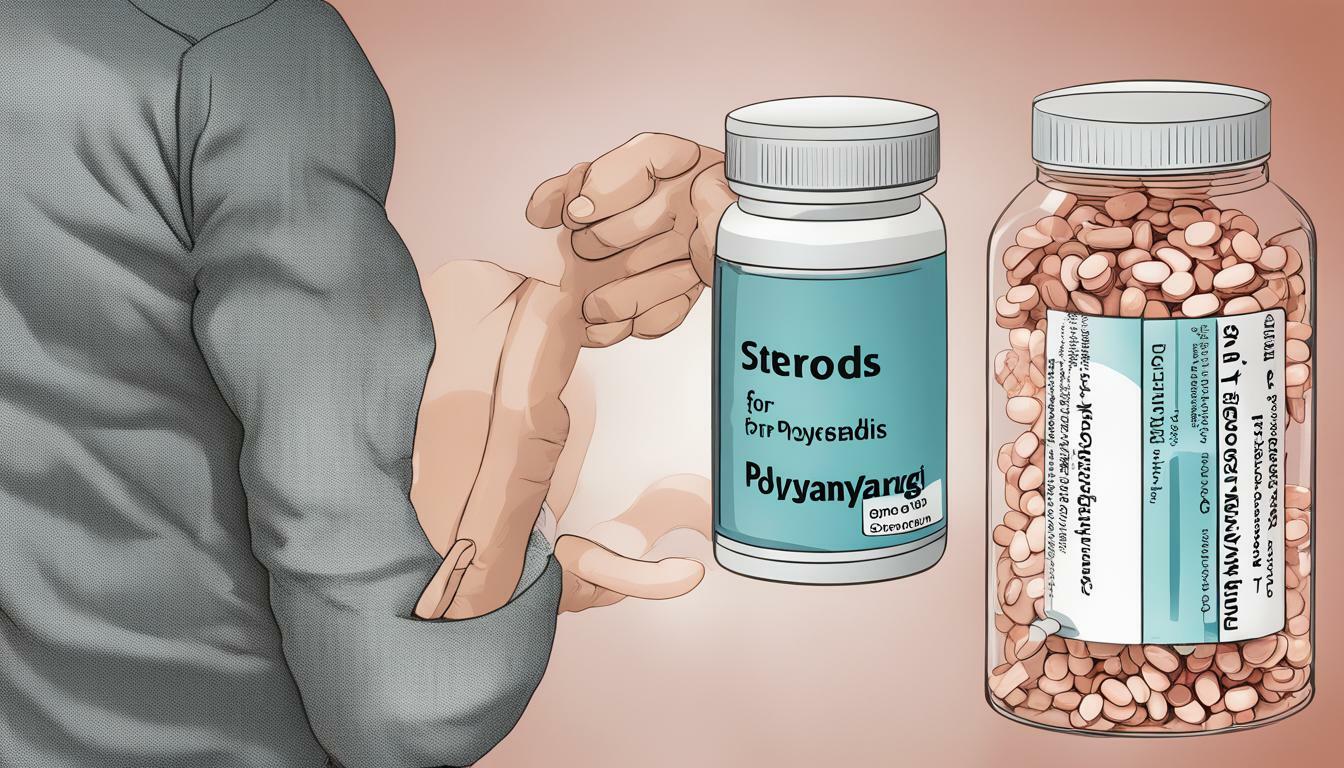Uncovering How Long You Can Take Steroids for Polymyalgia
Polymyalgia is a condition that causes inflammation in the muscles and joints, leading to pain and stiffness in the shoulders, hips, and neck. Treatment usually involves the use of steroids, which can be highly effective in managing symptoms. However, the duration of steroid treatment for polymyalgia can vary depending on several factors.
In this section, we will delve into the various factors that determine how long you can take steroids for polymyalgia. We will discuss the recommended duration for short-term and long-term steroid use, potential benefits and risks, and strategies to taper off steroid treatment.
Key Takeaways
- Polymyalgia is a condition that causes pain and stiffness in the muscles and joints, requiring treatment with steroids.
- The duration of steroid treatment for polymyalgia varies depending on individual factors, symptom severity, and response to treatment.
- Short-term and long-term approaches to steroid treatment can be used, with careful monitoring for potential side effects.
- The decision to start, continue, or taper off steroid treatment should always be made in consultation with a medical professional.
Understanding Polymyalgia and Its Treatment
Polymyalgia is a condition that causes widespread pain and stiffness in the muscles, particularly in the shoulders, neck, and hips. It primarily affects individuals over the age of 50 and is more common in women than men. While the exact cause of polymyalgia is unknown, it is believed to involve inflammation of the tissues surrounding the affected joints.
Steroids are often used to treat polymyalgia because they can effectively reduce inflammation and alleviate the associated pain and stiffness. However, the duration of steroid treatment can vary depending on several factors.
When used to treat polymyalgia, steroids are typically prescribed in moderate to high doses, with the goal of achieving symptom relief as quickly as possible. Once symptoms are under control, the dosage may be gradually reduced in order to minimize the risk of side effects.
Factors Influencing Steroid Treatment Duration
The length of time an individual with polymyalgia should take steroids varies depending on multiple factors. The aim of treatment is to control inflammation and relieve symptoms while minimizing the risk of adverse effects caused by long-term use of steroids.
One of the primary considerations is the severity of symptoms. In some cases, short-term steroid treatment may be sufficient to manage mild symptoms. In contrast, individuals with more severe symptoms may require long-term use of steroids.
Another factor is the response to treatment. If symptoms improve, it may be possible to reduce the dose of steroids gradually. Conversely, if symptoms persist or worsen despite treatment, longer-term use of steroids may be necessary.
However, there are limitations to the duration of steroid treatment for polymyalgia. Prolonged use of steroids can increase the risk of side effects such as osteoporosis, cataracts, and diabetes. Therefore, healthcare professionals must weigh the potential benefits and risks of treatment and determine the maximum duration of steroids for each individual.
Long-term use of steroids for polymyalgia
For individuals with persistent or recurring symptoms, long-term use of steroids may be necessary. This approach typically involves a higher dose of steroids for a longer duration than short-term treatment. However, long-term use of steroids must be carefully monitored to minimize the risk of side effects.
Regular follow-up appointments with a healthcare professional are essential for monitoring symptoms and potential side effects of steroids. Bone density scans, eye exams, and blood sugar monitoring may also be required to detect and manage any complications associated with long-term steroid use.
In conclusion, the duration of steroid treatment for polymyalgia should be determined based on the severity of symptoms, treatment response, and potential risks of long-term steroid use. Healthcare professionals must monitor symptoms and manage side effects to ensure a safe and effective treatment plan for each individual.
Short-Term Steroid Treatment for Polymyalgia
In some cases, a short-term course of steroid treatment may be sufficient to manage the symptoms of polymyalgia. The duration of short-term treatment typically lasts between four and six weeks, and the dosage varies depending on individual needs. According to the American College of Rheumatology, a starting dose of prednisone between 12.5 to 25 milligrams per day is recommended for most patients.
The benefits of short-term steroid treatment include rapid relief of symptoms and a lower risk of side effects compared to long-term use. However, it is important to note that short-term steroid treatment may not be effective for all patients, and some individuals may require longer periods of treatment to achieve symptom relief.
The maximum duration of steroid treatment for polymyalgia depends on the individual’s response to treatment and any potential side effects. In most cases, short-term treatment is tapered off gradually to minimize the risk of withdrawal symptoms and ensure a safe transition off the medication.
Long-Term Use of Steroids for Polymyalgia
For individuals with persistent or recurring symptoms, long-term use of steroids may be necessary. However, this approach comes with potential risks and considerations that must be carefully monitored and addressed.
The risks associated with long-term use of steroids for polymyalgia include increased susceptibility to infections, osteoporosis, cataracts, and high blood sugar levels. Your healthcare professional will monitor for these and other potential side effects and adjust your treatment plan as needed.
In addition to monitoring for side effects, strategies to minimize the risks associated with prolonged steroid use may include using the lowest effective dose for the shortest possible time, avoiding certain medications and activities that can exacerbate side effects, and regularly scheduling bone density scans.
Managing Side Effects
If you experience side effects from long-term steroid use, your healthcare professional may recommend additional treatment or adjustments to your medication. For example, osteoporosis may be treated with calcium and vitamin D supplements, and high blood sugar levels may be managed through changes to your diet or insulin therapy.
Tapering Off Steroids
When the symptoms of polymyalgia are well-controlled, it is important to gradually reduce the steroid dose and eventually discontinue treatment. This must be done under medical supervision to avoid potential withdrawal symptoms, which can include fatigue, muscle weakness, joint pain, and fever. Your healthcare professional will work with you to create a tapering schedule that is safe and effective for your individual needs.
In conclusion, long-term use of steroids for polymyalgia may be necessary for some individuals, but careful monitoring and management of potential side effects is crucial. Work closely with your healthcare professional to develop a safe and effective treatment plan, and always follow their instructions for tapering off steroid treatment.
Tapering Off Steroid Treatment
When the symptoms of polymyalgia are well-controlled, healthcare professionals may recommend tapering off steroid treatment. This gradual process involves reducing the dose of steroids over time until they can be safely discontinued.
The duration of the tapering process may vary depending on individual circumstances. In some cases, it may take several weeks or even months to completely stop steroid treatment. During this time, it is crucial to work closely with healthcare professionals to monitor symptoms and ensure a safe and effective tapering plan.
It is important to note that tapering off steroid treatment too quickly can lead to a range of withdrawal symptoms, including fatigue, joint pain, and muscle stiffness. These symptoms are often temporary and can be managed with appropriate medical care.
For individuals who have been on long-term steroid treatment for polymyalgia, the tapering process may take longer and require careful monitoring for potential side effects. In some cases, it may be necessary to switch to alternative treatments to manage symptoms.
Overall, the tapering process is an important part of managing polymyalgia and ensuring that steroid treatment is used safely and effectively. With appropriate medical supervision and support, individuals can safely transition off steroid treatment and continue to manage their symptoms in other ways.
Conclusion
In summary, the duration of steroid treatment for polymyalgia can vary from person to person. Individual factors such as symptom severity and treatment response play a significant role in determining the length of treatment. Short-term and long-term treatment approaches may be used, and it is crucial to consult with healthcare professionals to ensure a safe and effective treatment plan.
When starting or considering steroid treatment for polymyalgia, it is important to understand the potential side effects and risks associated with prolonged use. Long-term use should be monitored closely, and strategies should be put in place to minimize risks.
When symptoms are well-controlled, it is essential to gradually reduce the steroid dose and eventually discontinue treatment under medical supervision. Withdrawal symptoms may occur, making it crucial to follow the tapering-off process carefully.
Consult a Healthcare Professional
The decision to start, continue, or taper off steroid treatment for polymyalgia should always be made in collaboration with a medical professional. They can provide guidance on the appropriate treatment duration, monitoring for side effects, and developing a plan to manage symptoms effectively.







